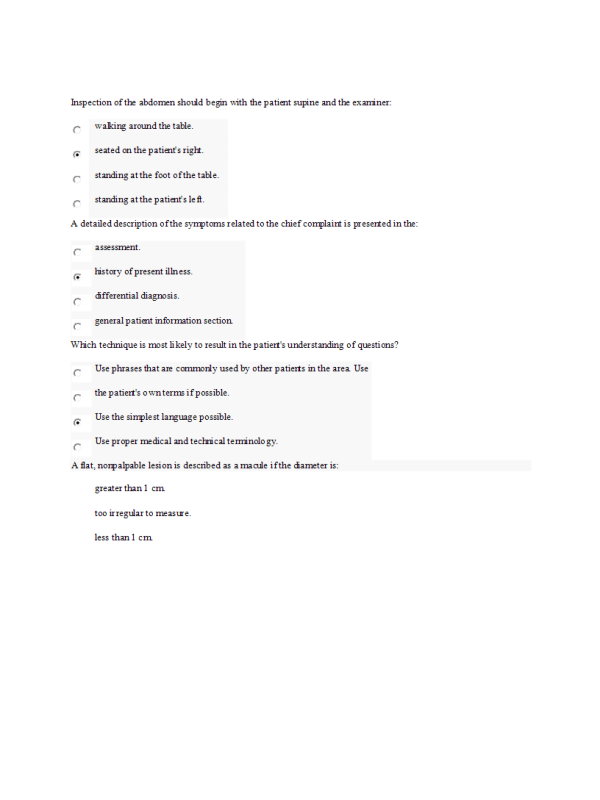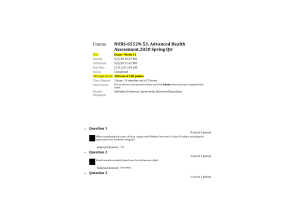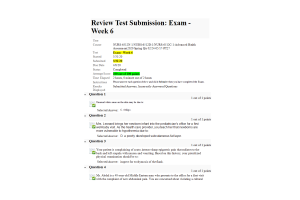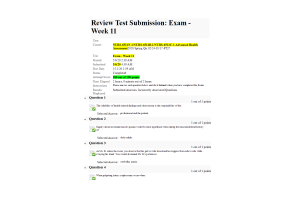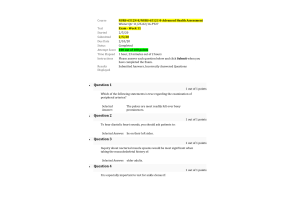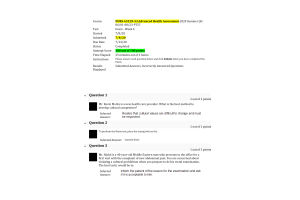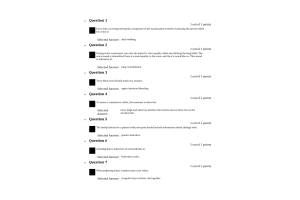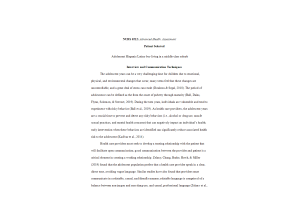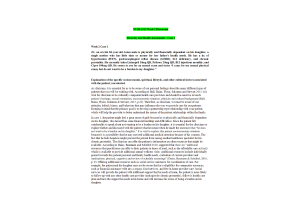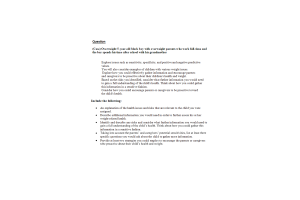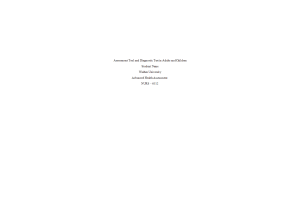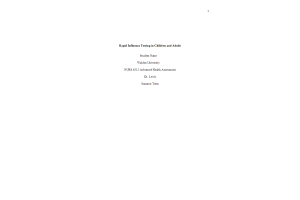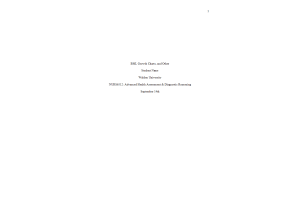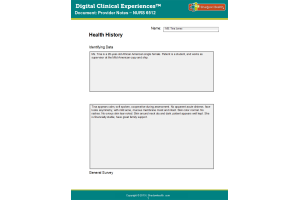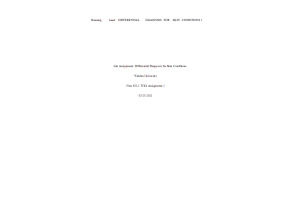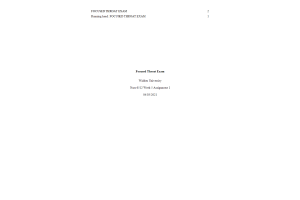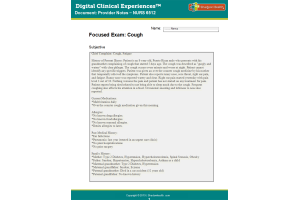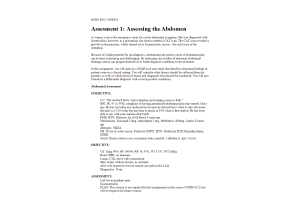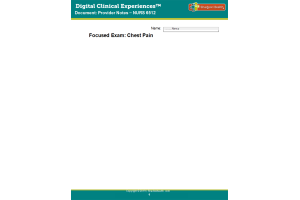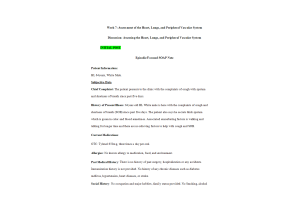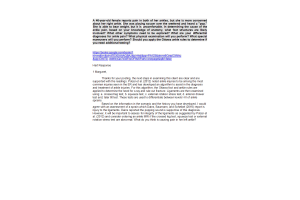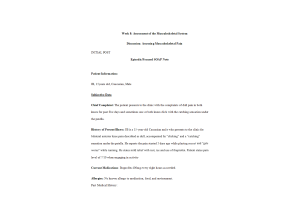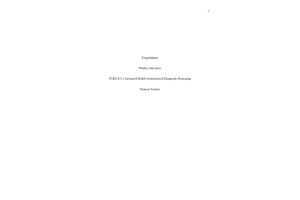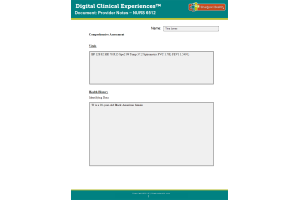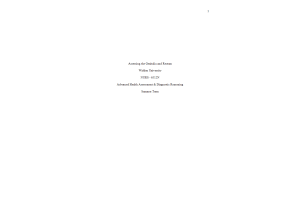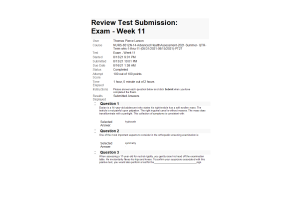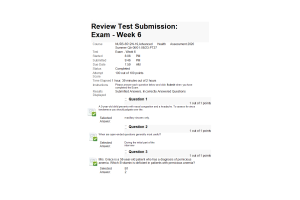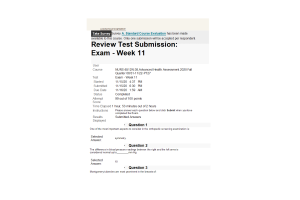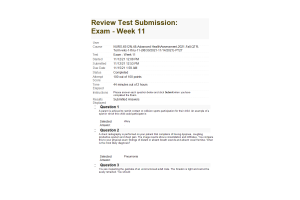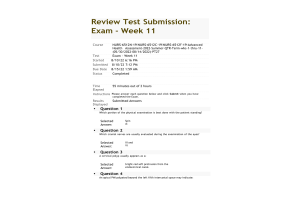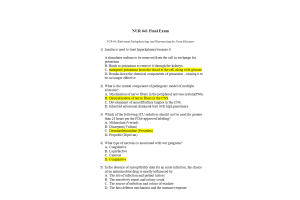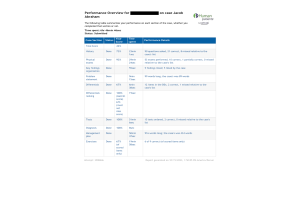NURS 6512N-50, Advanced Health Assessment; Week 6 Midterm Exam
- $39.00
- Question: Inspection of the abdomen should begin with the patient supine and the examiner:
- Question: A detailed description of the symptoms related to the chief complaint is presented in the:
- Question: technique is most likely to result in the patient's understanding of questions?
- Question: A flat, nonpalpable lesion is described as a macule if the diameter is:
- Question: Differential diagnoses belong in the:
- Question: A guideline for history taking is for caregivers to:
- Question: During an interview, tears appear in the patient's eyes and his voice becomes shaky. Initially, you should:
- Question: The examiner's evaluation of a patient's mental status belongs in the:
- Question: a 4' 3-cm, rough, elevated area of psoriasis. This is an example of a:
- Question: The infant should be placed in which position to have his or her height or length measured?
- Question: You are palpating a patient's thyroid and find that its broadest dimension measures 4 cm. The right lobe is25% larger than the left. These data would indicate:
- Question: Expected normal percussion tones include:
- Question: Knowledge of the culture or cultures represented by the patient should be used to:
- Question: Mrs. Hartzell is a 34-year-old patient who has presented for nutritional counseling becauseshe is a vegetarian. Deficiency of which of the following is a concern in the vegetarian diet?
- Question: A college student comes to the student health center complaining of difficulty in concentrating during classand while studying. The diet that would contribute to this problem is one that consumes mostly:
- Question: Which question would be considered a leading question?
- Question: Mrs. Tuber is a 36-year-old patient who comes into the health center with complaints that her fingernails are not growing. Which structure is the site of new nail growth?
- Question: Unusual white areas on the skin may be due to:
- Question: Which cranial nerves innervate the face?
- Question: During percussion, a dull tone is expected to be heard over:
- Question: Percussing at the right midclavicular line, below the umbilicus, and continuing upward is the correct technique for locating the:
- Question: Your patient returns for a blood pressure check 2 weeks after a visit during which you performed a completehistory and physical. This visit would be documented by creating a(n):
- Question: A fixed image of any group that rejects its potential for originality or individuality is known as a(n):
- Question: Your patient presents with symptoms that lead you to suspect acute appendicitis. Which assessment finding is least likely to be associated with this condition early in its course?
- Question: Your patient is complaining of acute, intense sharp epigastric pain that radiates to the backand left scapula with nausea and vomiting. Based on this history, your prioritized physical examination should be to:
- Question: In counseling a client regarding nutrition education, you explain that linoleic acid, a major fatty acid, is thought to be essential for:
- Question: When assessing abdominal pain in a college-age woman, one must include:
- Question: Under normal circumstances, how much water is lost daily by the body?
- Question: When assessing abdominal pain in a college-age woman, one must include:
- Question: As part of your health promotion education for a new patient, you explain that the risk factors for skin cancer include:
- Question: You are planning to palpate the abdomen of your patient. Which part of the examiners hand is best for palpating vibration?
- Question: After thorough inspection of the abdomen, the next assessment step is:
- Question: When communicating with older children and teenagers, you should be sensitive to their:
- Question: A blood pressure cuff bladder should be long enough to:
- Question: Small, minute bruises are called:
- Question: Macronutrients are so named because they:
- Question: The attitudes of the health care professional:
- Question: Nasal symptoms that imply an allergic response include:
- Question: Which type of speculum should be used to examine a patient's tympanic membrane?
- Question: Nuchal rigidity is most commonly associated with:
- Question: Mr. Black is a 44-year-old patient who presents to the clinic with complaints of neck pain that he thinks isfrom his job involving computer data entry. As the examiner, you are checking the range of motion in his neck and note the greatest degree of cervical mobility is at:
- Question: Mr. L. presents to the clinic with severe groin pain and a history of kidney stones. Mr. L.'s son tells you that, for religious reasons, his father wishes to keep any stone that is passed into the urine filter that he has been using. What is your most appropriate response?
- Question: George Michaels, a 22-year-old patient, tells the nurse that he is here today to "check his allergies." He has been having "green nasal discharge" for the last 72 hours. How would the nurse document his reason for seeking care?
- Question: To correctly document absent bowel sounds, one must listen continuously for:
- Question: Which statement is true regarding the relationship of physical characteristics and culture?
- Question: A 5-year-old child presents with nasal congestion and a headache. To assess for sinus tenderness you should palpate over the:
- Question: Mr. Sanchez is a 45-year-old gentleman who has presented to the office for a physical examination to establish a new primary care health care provider. Which of the following describes a physical, not a cultural, differentiator?
- Question: Ms. Jones is a 31-year-old female patient who presents for a routine physical examination. Which examination technique will be used first?
- Question: Mrs. G. reports an increase in her alcohol intake over the past 5 years. To screen her for problem drinking, you would use the:
- Question: What finding is unique to the documentation of a physical examination of an infant?
- Question: Your patient is complaining of acute, intense sharp epigastric pain that radiates to the back and left scapula with nausea and vomiting. Based on this history, your prioritized physical examination should be to:
- Question: Mr. Walters, a 32-year-old patient, tells you that his ears are "stopped up." An objective assessment of this complaint is achieved by using the:
- Question: Mrs. Raymonds is a 24-year-old patient who has presented for a routine concern over her current weight. In your patient teaching with her, you explain the importance of macronutrients. Which of the following is a macronutrient?
- Question: Tender forks with a frequency of 500 to 1000 Hz are most commonly used to measure:
- Question: As you explain your patient's condition to her husband, you notice that he is leaning toward you andpointedly blinking his eyes. Knowing that he is from England, your most appropriate response to this behavior is to:
- Question: Coarse, dry, and brittle hair is associated with which metabolic disorder?
- Question: When examining the skull of a 4-month-old baby, you should normally find:
- Question: You are using an ophthalmoscope to examine a patient's inner eye. You rotate the lens selector clockwise,then counterclockwise to compensate for:
- Question: To perform the Rinne test, place the tuning fork on the:
- Question: Mr. Jones is a 45-year-old patient who presents for a physical examination. On examination,you note costochondral beading, enlarged skull, and bowed legs and diagnose him with rickets. A deficiency of which fat-soluble micronutrient can result in rickets?
- Question: Mrs. Grace is a 58-year-old patient who has a diagnosis of pernicious anemia. Which
vitamin is deficient in patients with pernicious anemia?
- Question: Which of the following formats would be used for visits that address problems not yet identified in the problem-oriented medical record (POMR)?
- Question: Spasmodic muscular contractions of the head, face, or neck are called:
- Question: The term denoting the caregiver's need to do no harm to the patient is:
- Question: Mrs. Leonard brings her newborn infant into the pediatrician's office for a first well- baby visit. As the health care provider, you teach her that newborns are more vulnerable to hypothermia due to:
- Question: Subjective and symptomatic data are:
- Question: Which response would be most appropriate for enhancing communication?
- Question: Mrs. Britton brings her 16-year-old son in with a complaint that he is not developing correctly into adolescence. Which structures disproportionately enlarge in the male during adolescence?
- Question: A 22-year-old female nurse is interviewing an 86-year-old male patient. The patient avoids eye contact and answers questions only by saying, "Yeah," "No," or "I guess so." Which of the following is appropriate for theinterviewer to say or ask?
- Question: Bulging of an amber tympanic membrane without mobility is most often associated with:
- Question: Regardless of the origin, discharge is described by noting:
- Question: You are collecting a history from an 11-year-old girl. Her mother is sitting next to her in the examination room. When collecting history from older children or adolescents, they should be:
- Question: When taking a history, you should:
- Question: Peritonitis produces bowel sounds that are:
- Question: Mrs. Berger is a 39-year-old woman who presents with a complaint of epigastric abdominal pain. You have completed the inspection of the abdomen. What is your next step in the assessment process?
- Question: Placing the base of a vibrating tuning fork on the midline vertex of the patient's head is a test for:
- Question: The most common form of birth trauma of the scalp is:
- Question: Cherry angiomas are a common finding in:
- Question: Pigmented, raised, warty lesions over the face and trunk should be assessed by an experienced practitionerwho can distinguish:
- Question: You are completing a general physical examination on Mr. Rock, a 39-year-old man with complaints of constipation. When examining a patient with tense abdominal musculature, a helpful technique is to have the patient:
- Question: The position on a clock, topographic notations, and anatomic landmarks:
- Question: You have just completed a skin assessment on Mr. Baker. During your assessment, you have transilluminated a skin lesion. During the physical examination, you know that skin lesions are transilluminated to distinguish:
- Question: Before performing an abdominal examination, the examiner should:
- Question: Mr. Mills is a 55-year-old patient who presents to the office for an initial visit for health promotion. A survey of mobility and activities of daily living (ADLs) is part of a(an):
- Question: Sweat glands, hair, and nails are all formed from:
- Question: In examining the neck of a 34-year-old female patient, you note that the uppermost ridge of the tracheal cartilage is at the:
- Question: Which is the best way to position a patient's neck for palpation of the thyroid?
- Question: Peritonitis produces bowel sounds that are:
- Question: Mr. Abdul is a 40-year-old Middle Eastern man who presents to the office for a first visitwith the complaint of new abdominal pain. You are concerned about violating a cultural prohibition when you prepare to do his rectal examination. The best tactic would be to:
- Question: In issues surrounding ethical decision making, beneficence refers to the:
- Question: Before performing an abdominal examination, the examiner should:
- Question: Mr. Akins is a 78-year-old patient who presents to the clinic with complaints of hearing loss. Which of the following are changes in hearing that occur in the elderly? Select all that apply.
- Question: Mr. Kevin Marks is a new health care provider. What is the best method to develop cultural competence?
- Question: Tracheal tug suggests the presence of a(n):
